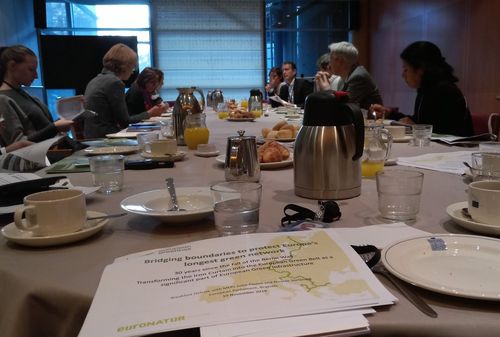Inspiring breakfast debate in the EU Parliament to bridge boundaries and protect Europe's longest green network
Members of the European Parliament (MEPs) and the EGBA discussed the many opportunities, but also challenges that arise with the conservation of the European Green Belt in the context of Green Infrastructure. A lively breakfast debate was held on 19 November 2019 in Brussels under the theme: Bridging boundaries to protect Europe’s longest green network – 30 years since the fall of the Berlin Wall - Transforming the Iron Curtain into the European Green Belt (EGB) as a significant part of European Green Infrastructure.

Co-host of the debate Jutta Paulus, MEP from Germany, introduced about 20 participants, further MEPs and assistants to MEPs, to the significant values of the European Green Belt. She highlighted the many conservation actions on the ground across the 24 states along the Green Belt as well as the historical and cultural aspects. In the past 30 years, since the fall of the Berlin Wall - marking the end of tensions of the cold war, the European Green Belt has become an extraordinary peace project, bringing together people of different cultures and countries. The Romanian co-host and MEP Nicolae Ștefănuță supported this statement and reminded of the cooperative efforts to conserve and connect natural habitats on the EGB. He stated that it is very relevant to foresee significant budget lines for the protection of biodiversity and green infrastructure. The current discussions about the MFF (Multiannual Financial Framework) shall be influenced in this sense. This statement was reinforced by Gabriel Schwaderer, Chair of the European Green Belt Association (EGBA) and CEO of EuroNatur: the budget reflects priorities. So, only if the budget is providing significant funds for green infrastructure, apparently it is a priority. Moreover, he presented how the concept of the European Green Belt has evolved and how it contributes to Green Infrastructure (GI) in Europe, today. Here, the EGB’s high potential for ecological connectivity, and being a model area for conservation and restoration of a functional ecological network by respecting the economic, social, and cultural needs of local communities, was highlighted. With its eight different biographical regions from the very North to the very South of Europe and the many NATURA2000/Emerald sites comes the importance of cross-border cooperation to secure the EGB’s outstanding ecological value. Today, the protected areas along the EGB serve as core areas of an EU-level GI. It was highlighted that the EGB can significantly contribute to EU-level GI-projects. However, there are enormous challenges to maintain and restore the ecological functions of this backbone of European Green Infrastructure. It underlines the requirement to support the EU Strategy on Green Infrastructure and to provide significant funding possibilities for measures to protect and develop Green Infrastructure and ecological connectivity in Europe through transnational, functional ecological networks. The EGBA has the following claims:
- For the full potential of GI to be realized within the next budgetary envelope (2020-2027), modalities to facilitate its integration into projects funded through financial mechanisms must be established as soon as possible.
- To further develop a Trans-European Network for Green Infrastructure (TEN-G) as an instrument to implement ecological connectivity throughout Europe and to establish appropriate funding mechanisms.
- To foster not only conservation actions for the EGB, but also secure the EGB as a peace project and memorial landscape.
In response, Stefan Leiner, Head of the Biodiversity Unit, DG Environment from the European Commission, strongly supported the concept of the EGB and stated that the EGB is an outstanding example for EU-level Green Infrastructure. As a fan of the EGB, he emphasized the importance of investments into green infrastructure projects in Europe so that biodiversity conservation and the preservation of the EGB as a memorial landscape has a real potential to become a priority of EU funding mechanisms.
